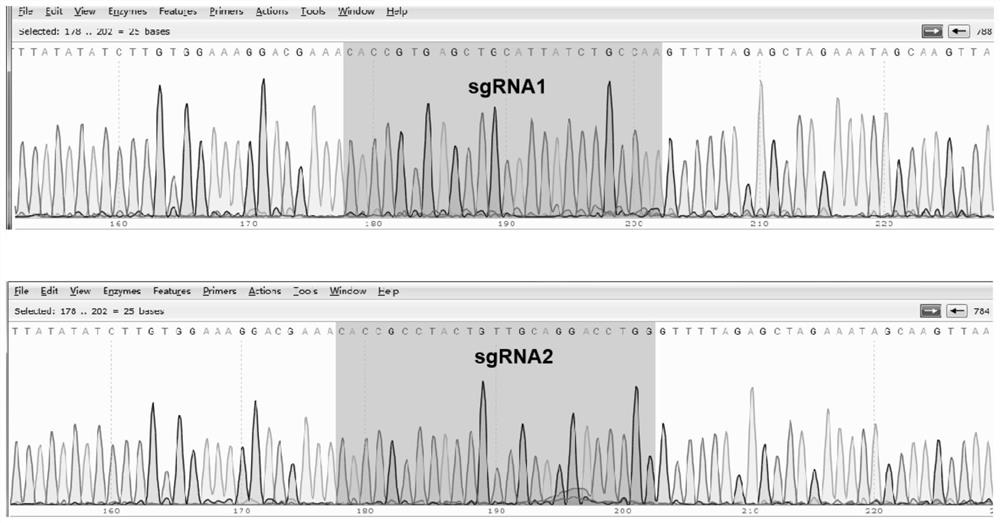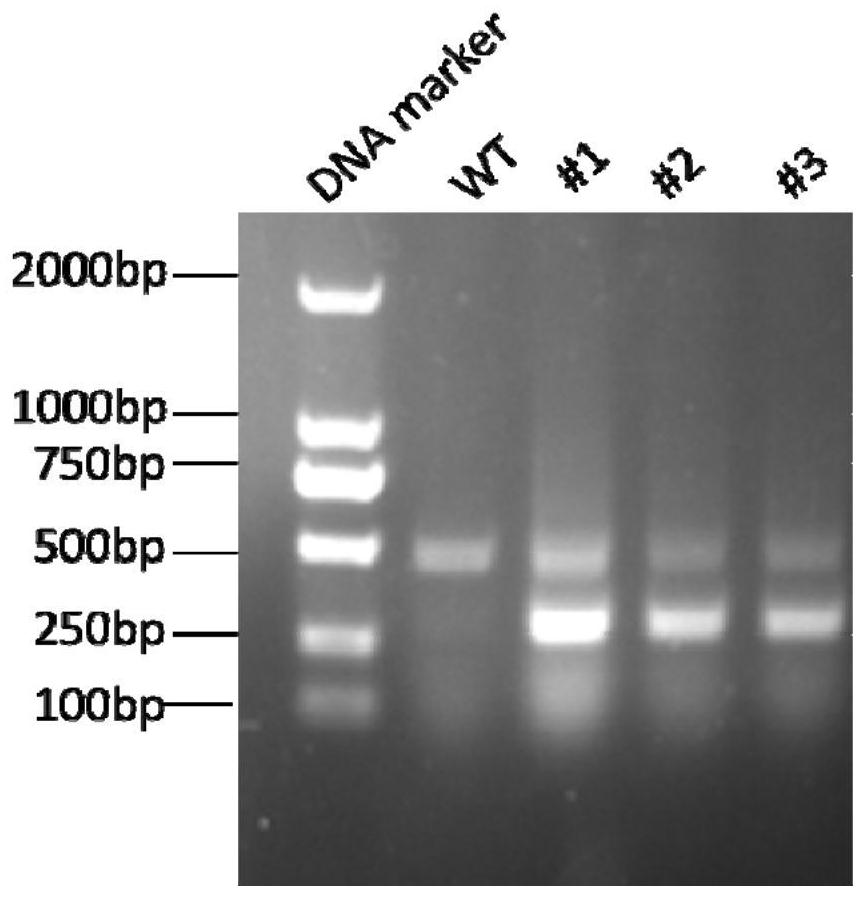Construction of RIPLET knockout cell line and application of RIPLET knockout cell line as picornaviridae virus vaccine production cell line
A small ribonucleic acid and cell line technology, applied in the field of genetic engineering, can solve the problems of useless commercial vaccine products, severe prevention and control situation, acute death of newborn piglets, etc., to improve production and antigen expression, knock out High efficiency and effect of promoting replication
- Summary
- Abstract
- Description
- Claims
- Application Information
AI Technical Summary
Problems solved by technology
Method used
Image
Examples
Embodiment 1
[0052] Example 1 Design of sgRNA targeting RIPLET gene
[0053] Use the NCBI database to query the RIPLET gene sequence, find the whole genome of the golden hamster (GenBank accession number: NW_004801729), locate the first exon segment of RIPLET in the overlapping region of different transcripts in the genome, and use it for target design.
[0054] According to the CRISPR / Cas9 design principle, log in to the CRISPR online design website http: / / crispr-era.stanford.edu / index.jsp to design sgRNA, select 2 pairs of 20bp sgRNA fragments according to the score, and name them respectively: RIPLET-sgRNAsp1( RIPLET-sgRNA1-F, shown in SEQ ID NO.3; RIPLET-sgRNA1-R, shown in SEQ ID NO.4), RIPLET-sgRNAsp2 (RIPLET-sgRNA2-F, shown in SEQ ID NO.5; RIPLET-sgRNA2-R, SEQ ID NO.6); Add CACC cohesive end at the 5' end of the forward sequence of the sgRNA fragment, and add AAAC cohesive end at the 5' end of the reverse sequence, as the sgRNA oligonucleotide (sgRNA1-oligonucleotide) targeting the R...
Embodiment 2
[0058] Example 2 Construction of sgRNA recombinant plasmid PX459-sgRNA
[0059] Obtaining double-stranded sgRNA-oligo: dilute the sgRNA-oligo synthesized in Example 1 to 10 μmol / L, and prepare a total of 10 μL reaction system: upstream primer 4.5 μL; downstream primer, 4.5 μL; 10×TaqBuffer, 1 μL. Reaction program: 99°C, 10min; 16°C, store; anneal the upstream and downstream primers to form a double-stranded sgRNA-oligo.
[0060] Digestion of PX459 vector plasmid: Digest the PX459 vector with BBSI restriction endonuclease, and prepare a total of 50 μl digestion system as follows: PX459 vector, 5 μL; BBSI, 2 μL; 10×Buffer, 5 μL; ddH 2 O, 38 μL. Place at 37°C for 3h for enzyme digestion. Afterwards, nucleic acid electrophoresis was performed, and the linearized fragment of the PX459 vector containing cohesive ends was purified and recovered using the DNA purification and recovery kit from Promega.
[0061] Construction of PX459-sgRNA recombinant plasmid: Ligate the purified an...
Embodiment 3
[0063] Example 3 Cell Transfection
[0064] Resuscitate BHK21 cells in T25 cell flasks before transfection, and culture them in DMEM medium containing 10% FBS and 1% double antibody. In the cell six-well plate, when the degree of cell confluence reached 70% to 80%, 2 μg each of the recombinant plasmids (PX459-RIPLET-sgRNA1 and PX459-RIPLET-sgRNA2) successfully constructed in Example 2 were mixed with Lipofectamine3000, 6 μL (according to Ratio 1 μg: 1.5 μL) was added to 50 μL of Opti-MEM, and the two were mixed after standing still for 5 minutes. The liposome-plasmid DNA mixture was allowed to stand for 15 minutes and then directly added to the cell culture medium. Return the cells to 37°C, 5% CO 2 Incubate for 24 hours in the incubator. Selection was performed with puromycin antibiotic for 72 hours.
PUM
 Login to View More
Login to View More Abstract
Description
Claims
Application Information
 Login to View More
Login to View More - R&D
- Intellectual Property
- Life Sciences
- Materials
- Tech Scout
- Unparalleled Data Quality
- Higher Quality Content
- 60% Fewer Hallucinations
Browse by: Latest US Patents, China's latest patents, Technical Efficacy Thesaurus, Application Domain, Technology Topic, Popular Technical Reports.
© 2025 PatSnap. All rights reserved.Legal|Privacy policy|Modern Slavery Act Transparency Statement|Sitemap|About US| Contact US: help@patsnap.com



